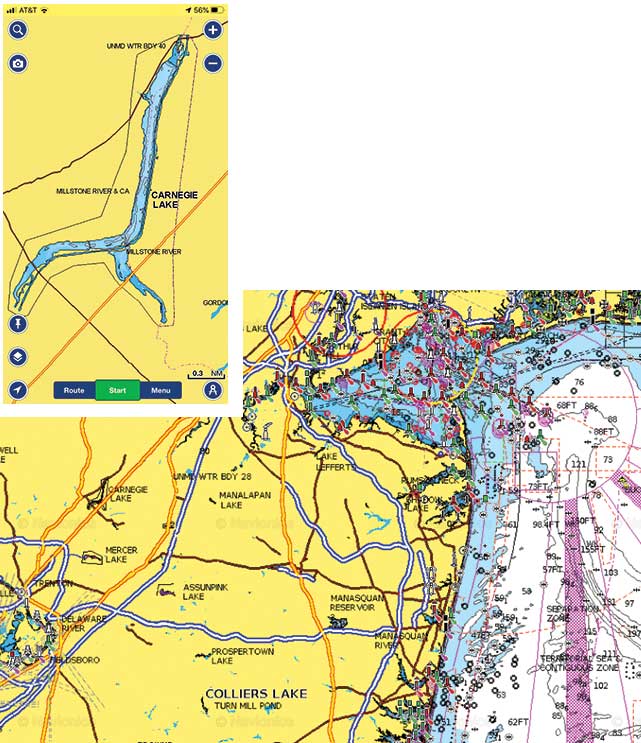Electrofishing conducted on Carnegie Lake by the NJ Division of Fish & Wildlife came up with the highest largemouth bass catch rate of 2018, according to the Freshwater Fisheries Annual Report. The Division specifically evaluated the largemouth bass population, and if you read that report, you might get the feeling they were blown away. Of 256 bass surveyed, 253 were greater than 200 mm long, and although only two measured more than 510 mm (almost 21 inches), five others measured between 500 and 509 mm.
Located in Princeton, Carnegie Lake is a 237-acre impoundment of the Millstone River. A public launch exists on State Highway 27 near the dam, motors limited to electric power. The Millstone enters the lake’s midsection after flowing under an aqueduct supporting the Delaware and Raritan Canal. Stony Brook also enters the lake, where you can find 20-foot depths at the pillars supporting railroad tracks. Otherwise, besides deep water near the aqueduct, the lake is shallow all the way across, the bottom muddy and water stained.
Near-shore lily pads are abundant. That’s where you should throw weedless worms, frogs, and flippin’ jigs. The pads typically come up in April. Where brush emerges from pads in 2 feet of water or more – not likely any deeper than 4 feet – fish that structure carefully, because structural breaks of any kind in the many acres of pads will hold bass.

Fish the bridge pillars, also. Many years ago, I fished a Mercer County Bassmasters tournament aboard a friend’s bass boat. He told me he caught his biggest bass, a 7-pounder, on Carnegie Lake. In detail, he described how he cast to timber built up around a bridge piling. As I recall, he explained his mistake of casting downstream to the wood.
Although Carnegie Lake’s current is more or less imperceptible, when the two feeder streams flood excessively, the lake can seem more like a river. Whole tree-trunks float into the lake on occasion after heavy storms, and my partner felt it a matter of good form to fish the pillars as if fishing a river, even though the lake wasn’t flooded then.
The lake is narrow – just 3 miles long, yet only 237 acres. Most of that acreage has no structure to hold bass. The bottom is muddy and flat, but large gizzard shad swim open water, providing rich forage for lunker bass. Casting blindly is a waste of time, but when the surface is calm, look for what people who fly-fish redfish call nervous water. Shad can make themselves evident if they fin at the surface, and by casting outsized lipless crankbaits to the edge of a school, you might score some exceptional action.
I once cast a crankbait that got down 6 or 7 feet near the aqueduct in March, probing that deeper open water, and I hooked up twice. The pads are not necessarily the only solution to fishing Carnegie, but they are the most obvious resort. Just keep in mind that bass have a way of seeming to anticipate your approach. Often, successful fishing is a game of unexpected plays.
If you have time, don’t overlook the headwater. And if you read elsewhere about Carnegie, you will be informed that it is an impoundment of the Millstone River. This information is correct, but misleading. The Millstone was dammed in 1905, but Stony Brook, which once formed a confluence with the Millstone upstream of that dam, is about as large a stream. Before the Millstone flows under the D & R Canal to empty into Carnegie, it exists as a series of large, pad-studded ponds all the back to U.S. Highway 1 and further eastward, but it soon narrows between the banks of a not-so-wide stream.
Where Stony Brook enters the lake, the placement of a railway bridge resulted in the digging of a deep hole providing largemouths refuge. I once cast a crankbait that got down at least 10 feet, catching one bass after another by working it directly against the concrete of a pillar. Good ones, too. It might also be possible that smallmouth bass hold near that concrete on occasion. Upstream of mud bottom as the flow nears Carnegie Lake, Stony Brook is a freestone smallie stream.
In any case, the largemouth isn’t Carnegie’s only gamefish. Muskellunge were stocked as late as 2017. Pickerel exist, but not as commonly as largemouth. Bluegills, yellow perch, white perch, all provide anglers action. The area of the aqueduct produces crappies early and late in the year.


